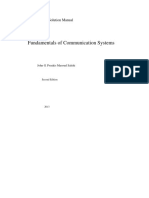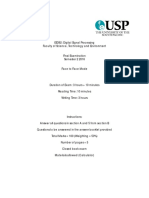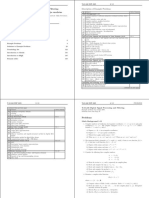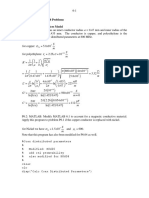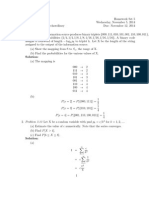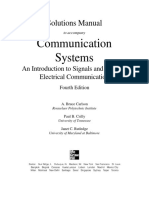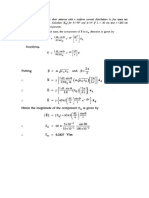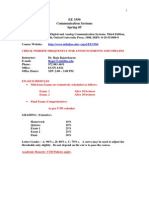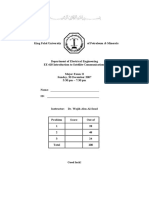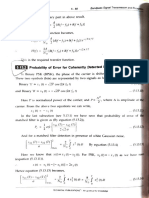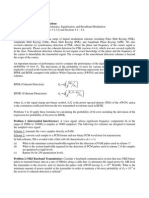0 ratings0% found this document useful (0 votes) 169 views15 pagesPractica Pasobanda
Ejercicios modulación pasobanda
Copyright
© © All Rights Reserved
We take content rights seriously. If you suspect this is your content,
claim it here.
Available Formats
Download as PDF or read online on Scribd
Feactleg #2 Weeder faobarcla Arfy Fl Ratey
Goes
4.1, Find the expected number of bit errors made in one day by the following continu-
ously operating coherent BPSK receiver. The data rate is 5000 bits/s. The input
-A cos wot where A = 1 mV
and the single-sided noise power spectral density is Ny = 10" W/Hz. Assume
that signal power and energy per bit are normalized relative to a 1-02 resistive
load.
—x
G(R) =@(JRE) tesa® >
Azlmv Te zone * No = owls
iS
%b > = Q [ze = Ql) = Ror)
Pe { 7 IO 4 ib”
ee = 03 x10
Gremeelle dh ores vn un ha
(vece LG) ( 86,00 spns/ia)( 4.05 x10"
= a bls Wer |�N¢2, to achieve a BER
4.4, Derive the minimum bit energy, Fy, to noise spectral density,
equal to 10° for the following cases:
(a) Polar baseband signal
(b) BPSK
(©) FSK
handy la eecndon 4-43
cle = CK-N@**
4.5. (a) Chiculate the minimum required bandwidth for a noncoherently detected
orthogonal binary FSK system. The higher-frequency signaling tone is 1 MHz
and the symbol duration is 1 ms,
(b) What is the minimum required bandwidth for a noncoherent MFSK system
having the same symbol duration?
(0 rina peparowles, le tare =
l= tf.
Af- 4° 10> (ote
bees ch siredigdee oon Mz y A He
= Lik
Anche & bard. brlno = +=
= 1K He, ¢ 2kH2
= Bkue�>) Cube de Vanda minioro para MPSK tocdhowrde ta (a
(AF SK v0 wunte, = m-lo 4 2
a T
F(mery(L) = Mt tHe
4,7, For detection of a received BPSK signal a correlator is used but the correlator intro-
duces a phase shift with reference to a carrier phase. Determine the probability of
error considering the phase error &.
Prsk
Bl = Accos Caf £ 4 ¢)
Slt= ~Accos(anfet +)
-@ (le)
Eye r §sw—% wFdb
+
bo
( “te bcos anf € sald = “ cos’( wf, £ +0) dt
ob _
| Fr zatn cat] Reg (Pees? } cone he Ae
a fee Q( lhe 2D an
[ ® ram)�48. Find the optimum (minimum probability of error) threshold yp, for detecting the
equally likely signals 5)(0) = V2E/T cos wot and s,(t) = 4 E/T cos (wot + 7) in
AWGN, using a correlator receiver as shown in Figure 4.7). Assume a reference
signal of (i) = V2/T cos wf.
Y= (Zest)
a4) =lE YW
O=ieY =
_
S(t) 2 caw eth Vz= tos lage +7)
Moe 4, +42 _ VE(- VE
ry D
4.12. (a) Consider 2 16-ary PSK system with symbol error probability P; = 10°. A Gray
code is used for the symbol to bit assignment. What is the approximate bit error
probability?
(b) Repeat part (a) for a 16-ary orthogonal FSK system.
Para PSK
@) 22 Pe 2 0° paxo |]
K 4
(6) Yara OFSK
P= 2 e.)
Z|�4.13, Consider a coherent orthogonal MFSK system with M = 8 having the equally likely
waveforms s,(1) = A cos 2nfi,i = 1,...,M, 0S tT, where T = 0.2 ms.The received
carrier amplitude, A, is 1 mV, and the two-sided AWGN spectral density, Ny/2, is
10" Wiz, Calculate the probability of bit error, Pp,
oo mee 2 3% 3
Fee (m1) (1%) B= LT (0) (ove
101° ~ a
fe = (8-1) a (=) = 2al2 26)
Aépun la tebola. fe 2 (0,002) = 6.69x0*
4.14, A bit error probability of Py = 10°*is required for a system with a data rate of 100
kbits/s to be transmitted over an AWGN channel using coherently detected MPSK
modulation. The system bandwidth is 50 kHz. Assume that the system frequency
transfer function is a raised cosine with a roll-off characteristic of r = 1 and that a
Gray code is used for the symbol to bit assignment.
(a) What ,/Np is required for the specified Ps? @ «= 288�4,15, Through a microwave link a bit stream is transmitted at a bit rate of 10° bits/s. What
will be the average carrier power required to maintain average probability of error,
no worse than 10“, after coherent detection? Receiver noise has a power spectral
density equal to 10°" W/Hz.
Ry = whbhlee = 2x We
Mo _
10 °vHe
a
c oa
SK ey 25
me \
hea ol) a(@) > ale) ~
ttomords & le Hla Rix) = 107
L= 2H
[B= ey-(6. 83m)
(3.89 (2 xo)
Uotonua dl anior
Po Eb = ERE 2(/9. Ber”) C10")
T P= 2.466 “mW
meee
A
ro�. A correlation receiver for a PSK system uses a cartier reference A sin wt. Two
equiprobable modulated signals s; and s, are given by s, = A sin (2 + 6) and
A sin (o,¢+ 05) and transmitted through an AWGN channel with noise spectral
Ny2. What will be the probability of correet coding?
zj
@Psk BPSK _—
_ I, Pp De mall
\
re Nog pra —~
iG we,
yest 4 Lnaornmltido os et
Ss
Nese 0 tparombido So °
tls) > cee or ERE)
- Te )�Pals) = , ;
cls) Grn J 4y <2)
- _ ee
at wife [| & =)
lo a “h f
life (XK) = e
ua So
J
2 - (rete) a
(else) = ele -LJ C de
dy Vero
a7 + eutke (2)
Pababllided total ch Lik on Over
i= Pd) Plels) + Plse) Pele)
= (leee(te) +E) (sent ())
f, = & arte (2)
Ie petoelidede ilfcaen oat�9.8. QAM signals are transmitted at a rate of 2400 symbols/s through a voiceband tele~
phone channel corrupted by white Gaussian noise. Determine E,/N, required to
achieve an error probability of 10~* at 4800 bits/s,
Ree 2100 syrlak (5 ce Ree td»
ST Rs eH0)
Roe be (1-200-a) 8a]
wt 2) aH"
= (Of (ee )]”
0, [FJ 20"
N,�9.10, You are required to make modulation and error-correetion code choices for a real-
time communication system operating over an AWGN channel with an available
bandwidth of 2400 Hz. The available £,/N, is 14 dB. The required data rate and bit-
error probability are 9600 bits/s and 10°, respectively. You are allowed to choose
one of two modulation types—either noncoherent orthogonal 8-FSK or 16-QAM
with matched filter detection. You are allowed to choose one of two codes—either
the (127, 92) BCH code or a rate + convolutional code that provides 5 dB of coding,
gain at a bit-error probability of 10-°, Assuming ideal filtering, verify that your
choices achieve the desired bandwidth- and error-performance requirements
Ry = 9600 4's!s
Rs
_ kb =
* Fay����









